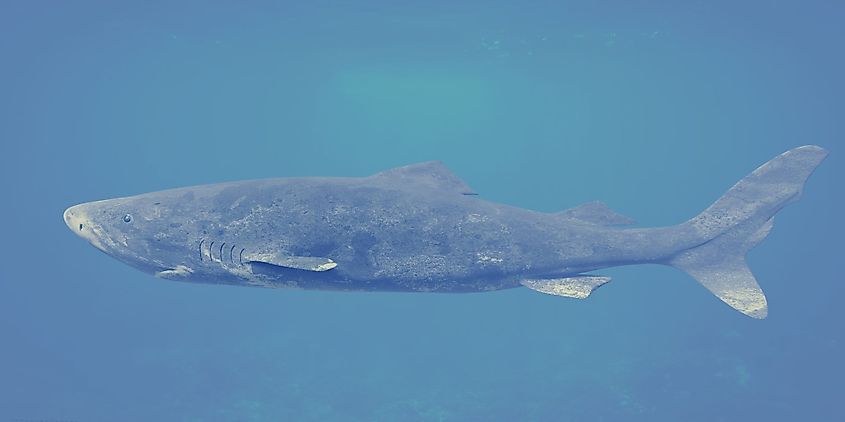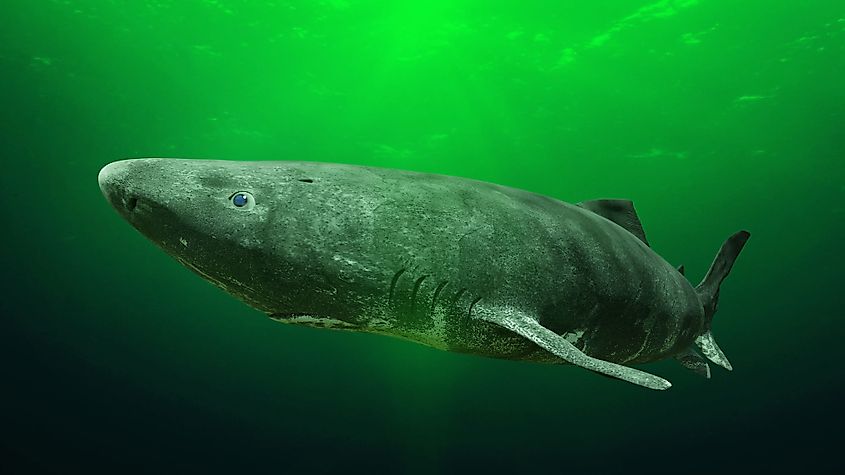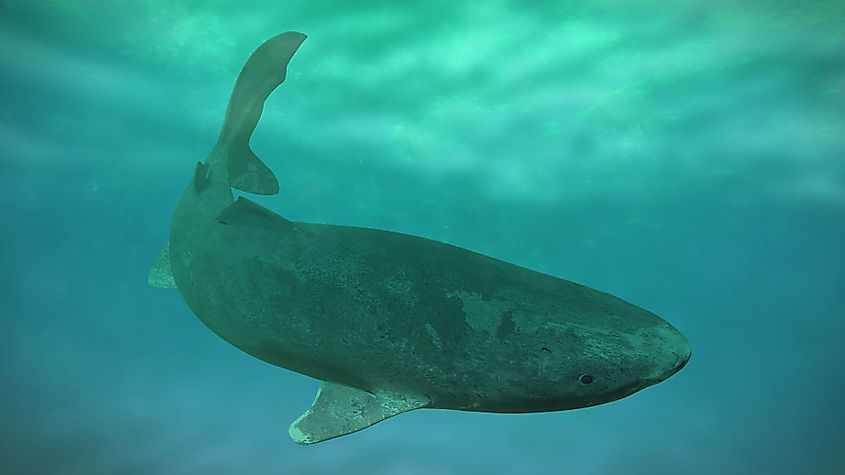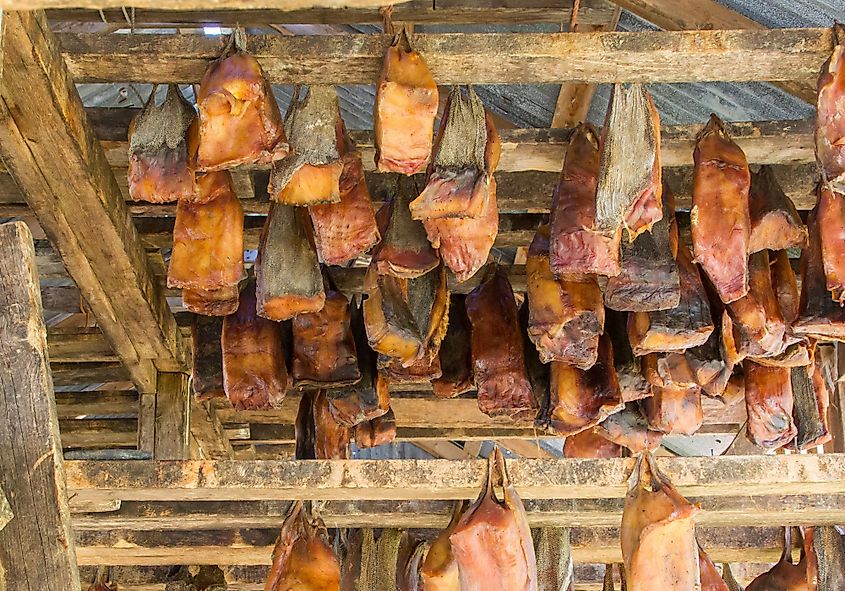
Greenland Shark
Sharks are a group of cartilaginous fishes that are characterized by having tough cartilaginous skin, robust jaws, multiple rows of sharp and replaceable teeth, five to six gill slits on the sides of their head, and pointed fins. Modern sharks are taxonomically classified in the Superorder Selachimorpha in the Subclass Elasmobranchii under the class Chondrichthyes. Currently, there are over 470 species of sharks that are found in the world’s oceans. These shark species are further grouped into 8 orders which are Carcharhiniformes, Heterodontiformes, Hexanchiformes, Lamniformes, Orectolobiformes, Pristiophoriformes, Squaliformes, and Squantiniformes.

Often referred to as the ‘gurry shark’, the Greenland Shark is a large species of shark, that is a member of the ‘sleeper shark family’ Somniosidae under the order Squaliformes. The Greenland Shark is closely related to the Southern and Pacific sleeper sharks and is commonly found in the cold, deep waters of the Arctic Ocean and the North Atlantic Ocean. The Scientific Name of the Greenland Shark is Somniosus microcephalus.
Description
The Greenland shark is one of the world’s largest living predatory shark species, which when fully grown reaches a length of 6.4m and weighs about 1,000kg. A typical Greenland shark is about 2.44 to 4.8m long and weighs around 400kg. These sharks possess smaller eyes, a short, blunt snout, and quite small pectoral and dorsal fins compared to their large body size. The body coloration of these sharks varies from pale creamy-gray to blackish-brown in color. The female sharks are comparatively larger than the male sharks and these sharks are ‘ovoviviparous’ producing an average of about 10 offspring at a time.
Greenland sharks possess narrow and pointed teeth in the upper jaw and broad, squared teeth in the lower jaw. These sharks hold their large prey with their upper teeth and then rolls their head in a circular motion, where the lower jaw teeth cut out chunks of flesh from their prey.
Distribution

Greenland sharks are considered to be the largest fish in the Arctic Ocean and the only shark species that can tolerate the cold Arctic throughout the year. The shark is also found in the North Atlantic Ocean, from the Baffin Bay to the Barents Sea. The Greenland sharks are also sometimes found in the North Sea and the waters surrounding the Atlantic Seaboard region of the United States.
Greenland sharks are quite infrequently observed on the ocean surface. They are found in the freezing waters whose temperature varies between -2° to 7°C and reaches a maximum depth of about 2,200m. During the summer months, the Greenland sharks migrate to extremely deeper parts of the ocean and during winters, these sharks move much closer to the water surface.
Movement

Greenland sharks are one of the slowest sharks that has the lowest swim speed. It is estimated that their swimming speed is about 1.22km/hour and their fastest cruising speed reaches only 2.6km/hour. Scientists believe that the shark’s slow speed correlates with its low metabolism and extreme longevity.
Poor vision
Greenland sharks have poor vision as their eyes are often colonized by Ommatokoita elongata – a copepod that attaches itself to the eyes of the shark. This small copepod causes corneal lesions leading to significant damage to the corneal tissue of the host shark. The corneal lesions lead to impaired vision or even partial blindness. In most cases, only one eye of the shark is often attacked by the copepod. However, this eye infection of the shark doesn’t significantly affect the shark as it relies more on other sense organs for movement and foraging in its dark habitat.
Diet
Greenland sharks are apex predators and feed mostly on other fishes. It has been recorded that the Greenland sharks feed on smaller sharks, eels, squids, and fishes like cod, herring, Arctic char, flounder, sculpins, etc. Due to their slow speeds, the Greenland sharks are opportunistic hunters and easily ambush their prey which are asleep. On examining the stomach contents of these sharks, scientists have found the remains of animals like polar bears, reindeer, and moose. Greenland sharks are also known to scavenge on seals. Therefore, as both apex predators and scavengers, the Greenland sharks play an important role in the complex food web of the Arctic ecosystems.
Longest Living Vertebrate
The Greenland Shark is the world’s longest-living vertebrate and can live for approximately 250 to 500 years. The age of many shark species is determined by counting the growth bands on their vertebrae. However, the soft vertebrae of the Greenland shark do not possess any such growth bands. Therefore, scientists determine the age of these sharks by performing radiocarbon dating of the crystals that are located within the lenses of the shark’s eyes. The studies also revealed that the Greenland shark reaches their sexual maturity when they are around 150 years old.
Greenland Sharks as food

To increase their buoyancy, these large sharks have a high concentration of urea and trimethylamine N-oxide (TMAO) in their tissues. Due to this reason, the flesh of the Greenland shark is considered to be extremely toxic and its consumption can lead to vomiting, diarrhea, convulsions, etc. The meat of the shark can be safely consumed only after proper cleaning and boiling before consumption. In Iceland, the shark meat is fermented for several months to produce kaestur hákarl, their national dish.
Threats
Some of the major threats faced by the Greenland shark include commercial fishing, bycatch, anthropogenic climate change, and pollution. Since the beginning of the 19th century, Greenland sharks have been commercially fished. In the 1960s, the sharks were targeted for their liver oil and it is estimated that about 30 gallons of liver oil can be obtained from a large shark. Numerous sharks were caught annually from the Arctic waters and about 3,500 sharks were caught as bycatch from the waters of the Barents Sea and the Arctic and Atlantic Oceans every year. Although the amount of annual catch has significantly reduced, nevertheless, commercial fishing continues to pose a great threat to these Greenland sharks.
Greenland sharks are also threatened by anthropogenic climate change. Global warming has been leading to the retreat of the Arctic Sea ice. The accelerated loss of sea ice affects the abundance, availability, and distribution of prey species of the Greenland sharks. This in turn forces the sharks to migrate to other environments in search of food. The retreating ice will also lead to the development of new fisheries in the warm waters of the Arctic which will further threaten the Greenland sharks.
It is estimated that the population of Greenland sharks is quite low and these sharks have a slow growth rate, lower reproduction rate, late maturity period, and extreme longevity making them more vulnerable to the various threats they are already facing. The International Union for the Conservation of Nature and Natural Resources (IUCN) has classified the Greenland Sharks as ‘Vulnerable’ species.











